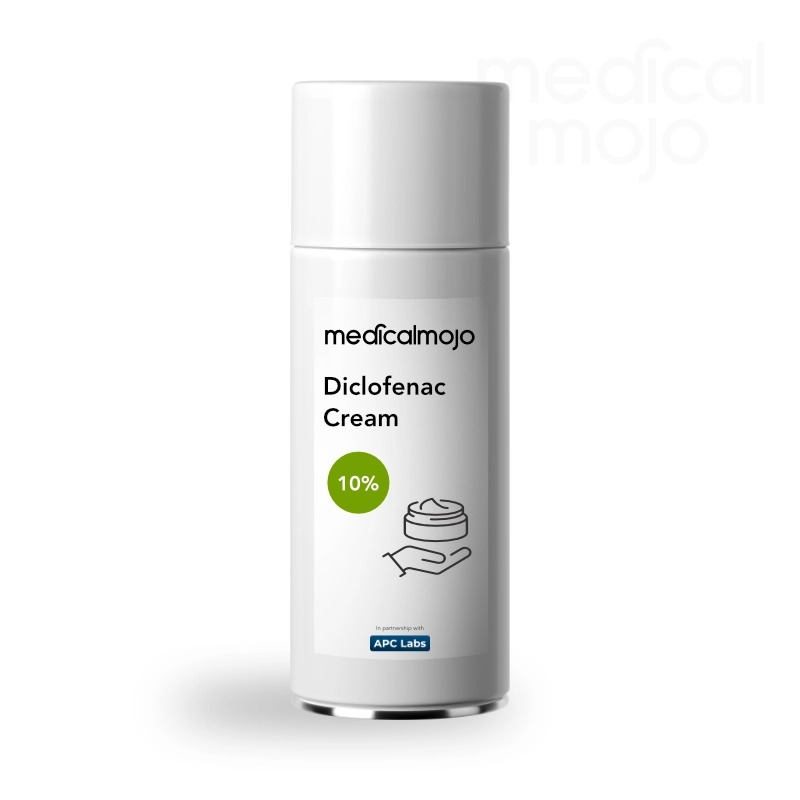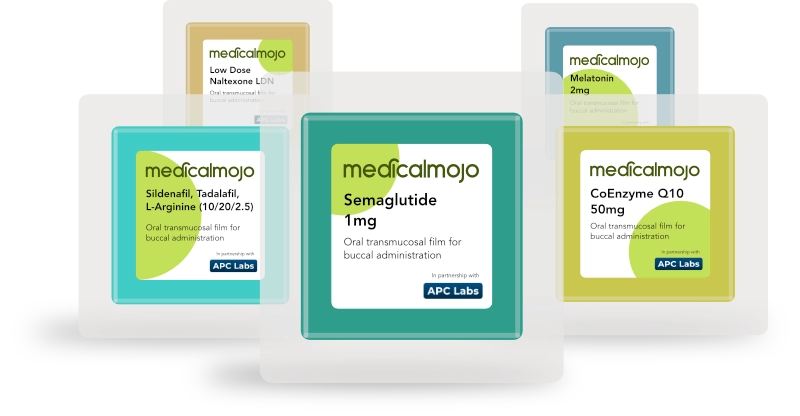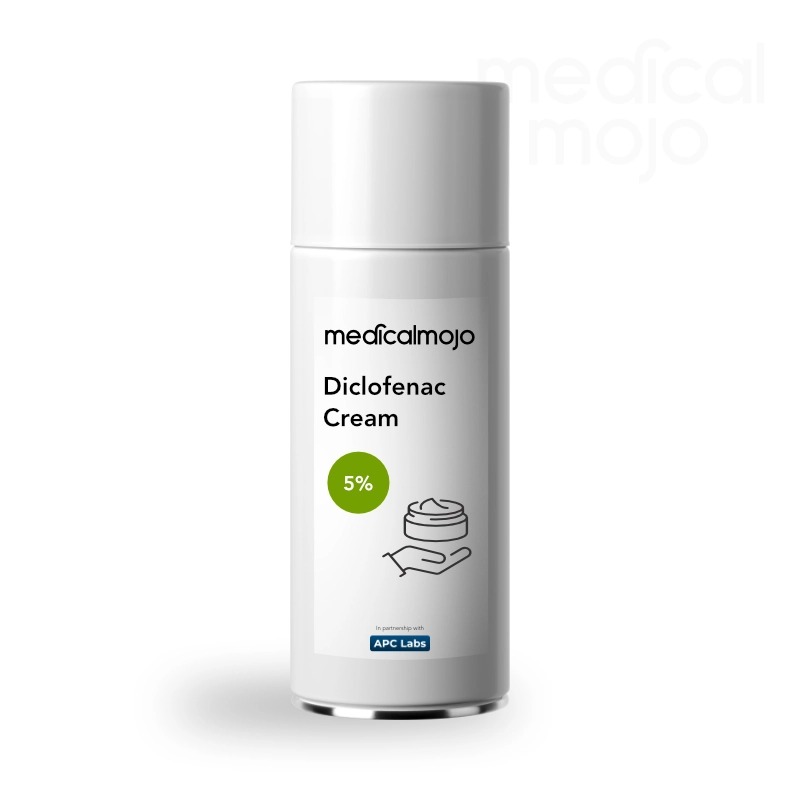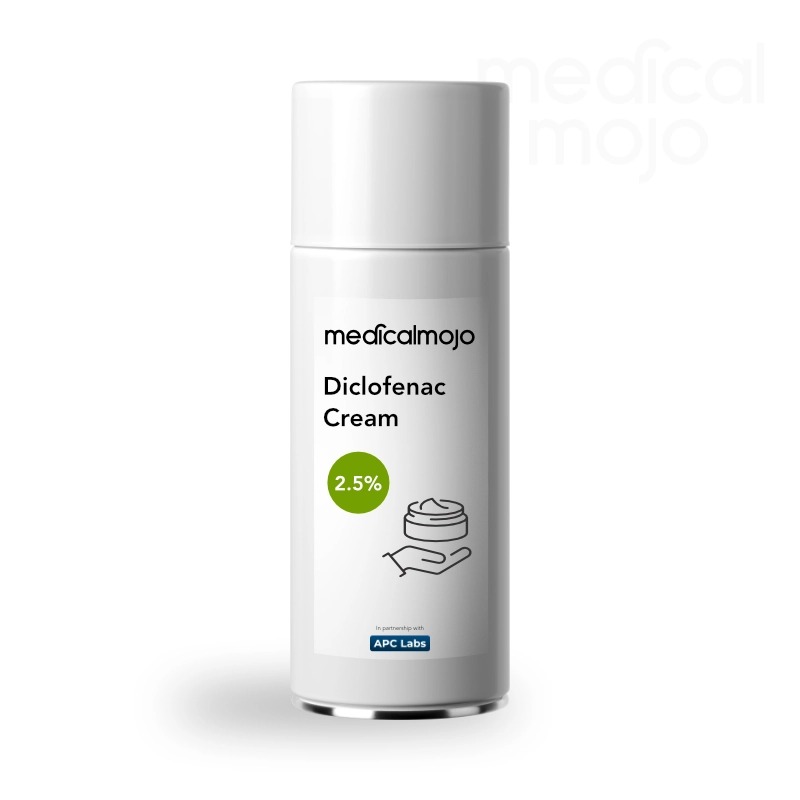What is Diclofenac 10% cream?
Diclofenac 10% cream is a specially compounded topical medication designed to provide powerful and targeted relief from pain and inflammation. As a high-strength nonsteroidal anti-inflammatory drug (NSAID) cream, it is formulated to address more severe conditions such as osteoarthritis, tendonitis, and muscle injuries.
This advanced cream works by directly targeting the affected area, reducing inflammation and alleviating discomfort without the systemic side effects often associated with oral NSAIDs. Its lightweight, fast-absorbing, and non-greasy formula ensures convenient application while delivering localised relief exactly where it’s needed.
Diclofenac 10% cream offers a significantly higher strength than standard prescription topical diclofenac products, which are typically limited to 2.32%. This makes it an excellent option for individuals requiring a more potent formulation to effectively manage pain and inflammation.
At Medicamojo.co.uk, we are committed to delivering high-quality, tailored treatments like Diclofenac 10% cream. Each product is carefully compounded to ensure optimal safety and effectiveness, providing a personalised approach to pain relief that meets your unique health needs.
What is the active ingredient in Diclofenac 10% cream?
The active ingredient in compounded Diclofenac 10% cream is diclofenac sodium, a potent nonsteroidal anti-inflammatory drug (NSAID). Each 100g of the cream contains 10g of diclofenac sodium, providing a higher-strength formulation designed for effective relief from pain and inflammation.
Diclofenac sodium works by inhibiting the production of chemicals in the body, such as prostaglandins, that trigger inflammation and discomfort. This makes Diclofenac 10% cream an excellent choice for targeted, localised pain management, helping to reduce swelling and ease discomfort directly at the source.
What is Diclofenac 10% cream used for?
Compounded Diclofenac 10% cream is a high-strength topical anti-inflammatory treatment specifically formulated to provide effective relief from pain and inflammation in targeted areas of the body. With a much higher concentration of diclofenac compared to standard prescription creams (typically limited to 2.32%), it offers a potent solution for individuals requiring advanced pain management.
This cream is particularly useful for:
- Osteoarthritis: Alleviates joint pain and stiffness, especially in commonly affected areas like the knees, hands, and shoulders.
- Muscle Strains and Sprains: Delivers fast and effective relief for minor injuries caused by physical activity or overuse.
- Tendonitis: Reduces swelling and discomfort in tendons, making it an ideal choice for sports-related injuries.
- Localised Pain: Targets specific areas of discomfort without affecting the rest of the body, ensuring precise and effective treatment.
Compounded Diclofenac 10% cream is tailored to meet individual needs, providing a customised approach to managing pain and inflammation. By applying the cream directly to the affected area, it delivers fast-acting relief while minimising the systemic side effects commonly associated with oral NSAIDs.
This advanced formulation offers convenience, precision, and reliable results, making it an excellent choice for those seeking targeted and effective pain relief.
How does Diclofenac 10% cream work?
Diclofenac 10% cream is a high-strength topical anti-inflammatory treatment designed to target pain and inflammation directly at the source. Its active ingredient, diclofenac sodium, is part of the nonsteroidal anti-inflammatory drug (NSAID) family, known for effectively reducing inflammation and discomfort.
Reduces inflammation
Diclofenac sodium works by inhibiting the production of prostaglandins—chemicals in the body responsible for causing inflammation, swelling, and pain. By reducing these chemicals, the cream helps alleviate discomfort and restore mobility in the affected area.
Localised relief
Unlike oral medications, Diclofenac 10% cream is applied directly to the area of pain or inflammation. This allows the active ingredient to penetrate the skin and target the underlying tissues, delivering relief precisely where it’s needed without affecting the rest of the body.
Minimises side effects
Since the cream is used topically, the amount of diclofenac absorbed into the bloodstream is minimal. This reduces the risk of systemic side effects, such as stomach irritation or gastrointestinal problems, which are more commonly associated with oral NSAIDs.
Fast absorption
The lightweight, non-greasy formula ensures the cream is quickly absorbed into the skin, allowing the active ingredient to reach the site of pain and inflammation rapidly, providing prompt and effective relief.
Whether you’re managing conditions such as osteoarthritis, tendonitis, or muscle injuries, Diclofenac 10% cream offers a powerful, convenient, and targeted solution to reduce pain and inflammation, helping you move more freely and get back to your daily routine.
How do you use Diclofenac 10% cream?
To achieve the best results from Diclofenac 10% cream, follow these steps for safe and effective use:
-
Clean and dry the area
Ensure the affected area is clean and completely dry before applying the cream. This helps maximise absorption and ensures the active ingredient works effectively.
-
Apply a thin layer
Dispense a small amount of Diclofenac 10% cream and gently spread a thin, even layer over the area experiencing pain or inflammation. Use only the amount recommended by your doctor or pharmacist.
-
Massage gently
Using soft, circular motions, massage the cream into your skin until it is fully absorbed. This helps the active ingredient penetrate the skin and reach the underlying tissues.
-
Wash your hands
After applying the cream, wash your hands thoroughly unless you are treating your hands. This prevents accidental contact with sensitive areas such as your eyes, mouth, or nose.
-
Follow the recommended frequency
Apply the cream 2-4 times daily, or as directed by your healthcare provider. Stick to the prescribed dosage and avoid exceeding the recommended amount.
-
Avoid certain areas
Do not apply the cream to broken, irritated, or infected skin. Keep it away from your eyes, mouth, and inside your nose to avoid irritation.
If you have any questions or concerns about using Diclofenac 10% cream, please contact us and one of our prescribers can advise you on the most suitable topical pain relief for you.
Who should not use Diclofenac 10% cream?
While Diclofenac 10% cream is a highly effective treatment for pain and inflammation, it may not be suitable for everyone. Avoid using this cream if any of the following apply to you:
-
Allergic to diclofenac or NSAIDs
Do not use this cream if you are allergic to diclofenac, aspirin, or other nonsteroidal anti-inflammatory drugs (NSAIDs).
-
History of severe allergic reactions
If you have experienced severe skin reactions, hives, or breathing difficulties (e.g., asthma) after using NSAIDs, avoid using Diclofenac 10% cream.
-
Broken or irritated skin
This cream should not be applied to broken, infected, or irritated skin, as it may worsen the condition or cause further irritation.
-
Pregnancy and breastfeeding
Consult your healthcare provider before using Diclofenac 10% cream if you are pregnant, planning to become pregnant, or breastfeeding. NSAIDs may pose risks during certain stages of pregnancy or while nursing.
-
Children under 14 years
Diclofenac 10% cream is not recommended for children under the age of 14 unless specifically prescribed by a healthcare professional.
-
Pre-existing health conditions
Speak to your doctor before using this cream if you have:
- A history of stomach ulcers or gastrointestinal bleeding.
- Severe liver or kidney problems.
- Heart-related conditions or high blood pressure.
- Using other medications
Avoid using Diclofenac 10% cream if you are already taking:
- Other NSAIDs (e.g., ibuprofen or aspirin).
- Blood thinners (e.g., warfarin or heparin).
- Medications that may interact with diclofenac.
Important advice
Always inform your doctor or pharmacist about any medications you are currently taking to avoid harmful interactions. If you are uncertain whether Diclofenac 10% cream is suitable for you, please contact us for a FREE consultation.
What are the side effects of Diclofenac 10% cream?
Diclofenac 10% cream is generally well-tolerated when used as directed, but like any medication, it may cause side effects in some individuals. Below are the potential side effects to be aware of:
Common side effects
These side effects are mild and often resolve on their own:
- Skin irritation, redness, or itching at the application site.
- Dry or flaky skin where the cream is applied.
Less common side effects
If you experience any of these, stop using the cream and consult your doctor:
- Rash or hives (urticaria).
- Burning or stinging sensation on the skin.
- Increased sensitivity to sunlight (photosensitivity), which may result in sunburn or irritation.
Rare side effects
These are uncommon but may require medical attention:
- Breathing difficulties, especially if you have asthma or a history of asthma.
- Swelling (angioedema) or severe allergic reactions.
- Stomach problems, such as nausea or indigestion, particularly if the cream is used in large amounts over an extended period.
Important notes
- Do not use Diclofenac 10% cream if you are allergic to diclofenac, aspirin, or other NSAIDs.
- Avoid applying the cream to broken, infected, or irritated skin.
- If you develop a rash or any unusual skin reaction, discontinue use immediately and consult a healthcare professional.
How to reduce the risk of side effects
- Use the cream exactly as prescribed by your doctor or pharmacist.
- Apply only the recommended amount to the affected area.
- Wash your hands thoroughly after applying the cream unless treating your hands.
- Protect your skin from excessive sun exposure and use sunscreen while using the cream.
If you have any concerns about potential side effects or notice anything unusual, contact your doctor or pharmacist for personalised advice.
Diclofenac 10% cream FAQs
1. What does it mean that Diclofenac 10% cream is compounded?
Compounded Diclofenac 10% cream is a specially prepared medication made in a pharmacy to meet individual patient needs. It is designed to provide an exact strength (10%) or formulation that is not commercially available.
2. Why is Diclofenac 10% cream compounded when 2.32% is the highest prescription strength available?
Diclofenac 10% cream offers a much higher concentration of diclofenac compared to the standard 2.32% prescription creams. This makes it suitable for patients who require stronger pain relief and inflammation management when standard options are insufficient.
3. How do I know if I need compounded Diclofenac 10% cream?
If prescription-strength diclofenac creams, such as 2.32%, have not provided adequate relief, your healthcare provider may recommend Diclofenac 10% cream. Its higher concentration is ideal for individuals needing more effective management of pain and inflammation.
4. What are the benefits of using compounded Diclofenac 10% cream?
- Provides a stronger, tailored strength for enhanced relief.
- Can include specific ingredients to avoid allergens or meet individual needs.
- Offers an alternative for patients who do not respond well to standard formulations.
5. Is compounded Diclofenac 10% cream safe?
Yes, when prepared by a licensed pharmacy, compounded Diclofenac 10% cream adheres to strict safety and quality standards. At Medicamojo.co.uk, our compounding team ensures every product is safe and effective through rigorous training and quality checks.
6. How is compounded Diclofenac 10% cream different from over-the-counter gels?
Over-the-counter gels, such as Voltarol, typically contain lower concentrations of diclofenac (e.g., 1.16%). Diclofenac 10% cream is a prescription-strength medication, providing a significantly higher dose for more effective and targeted relief.
7. Can I get compounded Diclofenac 10% cream without a prescription?
No, Diclofenac 10% cream requires a prescription from a healthcare professional. However, at Medicamojo.co.uk, you can complete an online health questionnaire to determine if this treatment is suitable for you.
8. What is Diclofenac 10% cream used for?
Diclofenac 10% cream is used to relieve pain and reduce inflammation in conditions such as osteoarthritis, tendonitis, muscle strains, sprains, and other localised joint or muscle issues.
9. How does Diclofenac 10% cream work?
Diclofenac, the active ingredient, is a nonsteroidal anti-inflammatory drug (NSAID) that blocks the production of chemicals in the body responsible for pain and inflammation. When applied to the skin, the cream provides localised relief without the systemic side effects of oral medications.
10. How do I use Diclofenac 10% cream?
Apply a thin layer of the cream to the affected area 2-4 times daily, or as directed by your doctor or pharmacist. Gently massage it into the skin until fully absorbed and wash your hands after applying unless treating your hands.
11. Who should not use Diclofenac 10% cream?
Avoid using this cream if you are allergic to diclofenac, aspirin, or other NSAIDs, are pregnant especially during the last three months, are under 14 years old, or have asthma or allergies triggered by NSAIDs.
12. What are the side effects of Diclofenac 10% cream?
Common side effects include mild skin irritation, redness, or dryness at the application site. Rarely, it may cause rashes, increased sensitivity to sunlight, or breathing difficulties in people with asthma. If side effects occur, stop use and consult a doctor.
13. Can Diclofenac 10% cream be used with other medications?
Be cautious when using this cream with other NSAIDs, blood thinners, or medications for high blood pressure, as interactions may occur. Always inform your doctor about all medications you are currently taking.
14. Can I use Diclofenac 10% cream during pregnancy or breastfeeding?
Diclofenac 10% cream should not be used during the last three months of pregnancy. If you are pregnant, planning to become pregnant, or breastfeeding, consult your doctor before using this cream.
15. Can I use Diclofenac 10% cream on broken skin?
No, you should only apply the cream to healthy, unbroken skin. Avoid using it on cuts, wounds, or infected areas, as it may cause irritation or worsen the condition.
16. Can I use Diclofenac 10% cream with a bandage?
Yes, you can use the cream with normal, non-airtight bandages. However, do not use it with airtight or waterproof dressings, as this may increase the risk of side effects.
17. What should I do if I experience a skin reaction or rash?
If you develop a rash, redness, or any unusual skin reaction after applying the cream, stop using it immediately and consult your doctor or pharmacist for advice.
18. Can I use Diclofenac 10% cream for chronic pain?
Yes, Diclofenac 10% cream can be used for chronic pain conditions such as osteoarthritis. However, long-term use should be monitored by your healthcare provider to minimise the risk of side effects.
19. How should I store Diclofenac 10% cream?
Store the cream in a cool, dry place away from direct sunlight and heat. Keep it out of reach of children and do not use it beyond the expiration date printed on the packaging.











